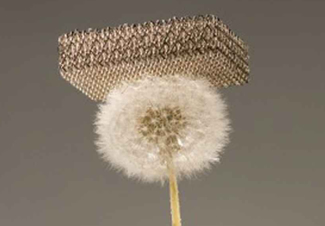| * |
Thursday, October 22, 2015
Lightest metal: Boeing sets world record (VIDEO)
NEW YORK, NY, USA -- Boeing created the lightest metal ever, a microlattice material which it describes as 99.99% air; looks like a sponge or a mesh, and is simultaneously flexible and very strong; it was jointly developed by HRL Laboratories, a joint venture between Boeing and General Motors, in collaboration with Cal Tech and UC Irvine; it weighs only about one tenth as much as carbon fiber, and is actually slightly lighter than air itself, thus
setting the new world record for being the Lightest metal,
according to the World Record Academy
.
Photo: The lattice in the metal is made up of interconnected hollow metal tubes - constructed from nickel, in the case of the prototype. Each of these tubes has a wall thickness of just 100 nanometres, which is 1,000 times thinner than human hair.
( enlarge photo
)
The Guinness World Records' record for the largest metal sculpture was completed by Gary Greff (USA) in August 2001, stands 110 ft (33.5m) tall, is 154 ft (46.9m) wide and weighs 157,659 lb (71,512.91 kg). Entitled Geese in Flight , the sculpture resembles Canadian geese flying against a backdrop of sky and prairie and is one of a series of metal sculptures located along the Enchanted Highway between Gladstone and Regent, North Dakota, USA.
Guinness World Records also recognized the world record for the largest metal mirror; it is a 183-cm (72-in) reflector, made by the third Earl of Rosse (1800-67), and set up at Birr Castle, Co. Offaly, Republic of Ireland in 1845. The mirror was made of speculum metal (an alloy of copper and tin).
Boeing describes the new microlattice as an "open cellular polymer structure." The main use of the material would be structural components, such as sidewall or floor panels of commercial jets.
The lattice in the metal is made up of interconnected hollow metal tubes - constructed from nickel, in the case of the prototype.
Each of these tubes has a wall thickness of just 100 nanometres, which is 1,000 times thinner than human hair. These open cells in the structure give microlattice huge compression potential, which means it can absorb a whole lot of energy.
The microlattice weighs only about one tenth as much as carbon fiber, and is actually slightly lighter than air itself, said Bill Carter, the director of the Sensors and Materials Laboratory at HRL.
It will likely first be used on space rockets that Boeing plans to build in about five years, and it should make its way into commercial planes about five years after that, said Carter.
He said the cost of manufacturing will have to come down a little more before it is economically feasible to use on cars.
Related world records:
Largest High Definition Video Display: Mitsubishi Electric breaks Guinness World Records' record (VIDEO)
Largest LED image display: Australia breaks Guinness World Records record (VIDEO)
Largest Digital Flatbed Printer: Dip-Tech breaks Guinness World Records' record (VIDEO)
Longest Operation of Thermal Power Plant Without Breakdowns: Boryeong Plant sets world record




